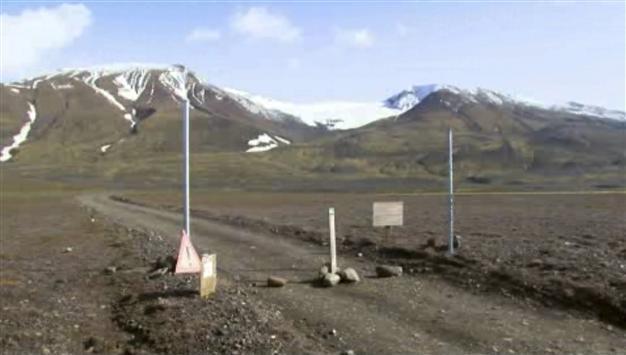Iceland raises avaiation alert to red after eruption at largest volcano
REYKJAVIK – Agence France-Presse

This is a Aug. 19, 2014 file image taken from video of a sign is posted on the road next to Bardarbunga, a subglacial stratovolcano located under Iceland's largest glacier. AP Photo
Iceland raised its aviation alert over the nation's largest volcano to red on Aug. 29, after the Bardarbunga peak began erupting overnight.
A ban on air traffic around the country's largest volcanic system was also put in place, but the authorities said there were no signs of spewing ash.
A major explosion at Bardarbunga, located under Europe's largest glacier, could signal a replay of the global travel chaos triggered when another Icelandic peak blew four years ago, creating a massive ash cloud across Europe.
Iceland's civil protection office said the eruption began just after midnight and had created a volcanic fissure of up to a kilometre (over half a mile) long.
"No volcanic ash has been detected by the radar system at the moment. The earthquake caused by the eruption is small, indicating an... eruption without significant explosive activity."
The alert around Bardarbunga was initially raised to red from orange on Aug. 23, which led to the closure of airspace in the affected area, although all airports in Iceland remained opened.
The aviation ban was lifted the following day although seismic activity in the area remained high, with earthquakes shaking the volcanic system more than 20 times an hour on Aug. 26 alone. One of the quakes measured 5.7, the most powerful in the area since 1996.
Several hundred people were evacuated earlier this week from the area, which is uninhabited, with only trekking cabins and campsites used by tourists and hunters in the summer months.
Bardarbunga, in the southeast of the country, is Iceland's second-highest peak, rising to more than 2,000 metres (6,500 feet).
The eruption of Eyjafjoell, a smaller volcano, in April 2010 caused travel mayhem, stranding more than eight million people in the widest airspace shutdown since World War II.
Iceland's most active sub-glacial volcano Grimsvotn erupted in 2011, forcing the country to temporarily shut its airspace and sparking fears of a repeat of the Eyjafjoell flight chaos. Iceland is home to more than 100 volcanic mountains, including some of the most active in the world.
